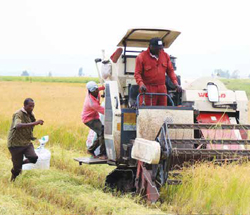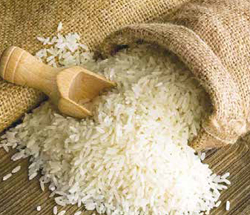Rice
 Rice is currently the third important staple crop after maize and wheat in Kenya. It can be considered as an alternative cereal to supplement maize as it is preferred by households in ASAL regions (WB 2011).
Rice is currently the third important staple crop after maize and wheat in Kenya. It can be considered as an alternative cereal to supplement maize as it is preferred by households in ASAL regions (WB 2011).
Despite the achievements in the last decade of NRDS Phase 1 (2008- 2018) in doubling rice production, the consumption has continued to rise bill. The increase in demand is attributable to the changing eating habits coupled with a growing population with high consumption by the youth. To meet this demand and reduce the import bill, calls for hard work among achievable through expansion of area under rice production as well as during the NRDS Phase 2 implementation. The actual irrigated area is targeted to increase from 32,988 - 171,676 Ha, while rain-fed production area is targeted to increase from 10,631 - 42,000 Ha by 2030. Paddy rice productivity under irrigation is targeted to increase from the current average of 4.0 to 7.5 t/Ha, rain-fed upland from 1.5 to 2.5 t/Ha and rain-fed lowlands from 2.0 to 3.5 t/Ha.
This NRDS targets to address various challenges faced by the stakeholders in the rice value chain and offers various opportunities for increased production and productivity. These challenges include high costs of production (seed, fertilizers, chemicals, machinery, labour); lack or access to these inputs; lack of credit facilities; erratic weather and water supply; high harvest and post-harvest losses; poor infrastructure in neighbouring countries and low rice value addition; among others. The interventions include development and dissemination of improved production technologies, introduction of high yielding rice varieties, along the value chain, improved knowledge and skills on harvest and postharvest handling and value addition in rice and rice by-products.
Research and extension will play a key role in ensuring that this objective is met. To address nutrition issues, deliberate efforts will be made to ensure production and consumption of nutritious rice meals. It is with this in mind that the NRDS Phase 2 (2019-2030) has been developed.
The NRDS Phase 2 will build on achievements made in phase 1 which ncluded use of hybrid seeds, development of the Water Saving Rice Culture, improved mechanization along the rice value chain, development and release of improved varieties, development of rice seed distribution system, capacity building for staff and farmers, construction of two rice research laboratories and improved networking among others.
It is notable that about 80% of rice in Kenya is mainly grown in irrigation schemes by small scale farmers while the rest is produced under rainfed conditions. The producers are highly fragmented which poses a challenge in meeting quality and quantity requirements for development Cooperative Society (MRGM) based in Mwea Irrigation Scheme is a good example on how farmers can benefit from organized rice farming.
 Currently, as part of the gazette notice of the Public Finance Management (Strategic Food Reserve Trust Fund) Regulations 2015, the strategic food reserve include maize, beans, rice, fish, powdered milk and canned beef. However, since 2015, the majority of the purchases have been for maize (>95%) with the rest of the purchases consisting of beans and powdered milk. The Government through a presidential directive through Kenya National Trading Corporation (KNTC) in the Ministry of Trade and Enterprise Development will be purchasing rice with a revolving fund of six hundred and sixty million in the major rice growing areas of West Kano and Mwea for purchase by local institutions in the country. This implies there will market for locally produced rice. The NRDS proposes formation of a Rice Council of Kenya that will increase private sector involvement in the rice value chain and mobilise funding to address the challenges. Mobilisation of a Rice Millers Association of Kenya will be done and the forum created to coordinate issues of mechanisation in the value chain. It is also expected that this increase will create 100 new enterprises along the rice value chain and 3 new producer marketing organization formed thus creation of employment and increase in the country’s gross domestic product. Value addition in rice and rice by-products will also be promoted so as to have at least three new value added products developed.
Currently, as part of the gazette notice of the Public Finance Management (Strategic Food Reserve Trust Fund) Regulations 2015, the strategic food reserve include maize, beans, rice, fish, powdered milk and canned beef. However, since 2015, the majority of the purchases have been for maize (>95%) with the rest of the purchases consisting of beans and powdered milk. The Government through a presidential directive through Kenya National Trading Corporation (KNTC) in the Ministry of Trade and Enterprise Development will be purchasing rice with a revolving fund of six hundred and sixty million in the major rice growing areas of West Kano and Mwea for purchase by local institutions in the country. This implies there will market for locally produced rice. The NRDS proposes formation of a Rice Council of Kenya that will increase private sector involvement in the rice value chain and mobilise funding to address the challenges. Mobilisation of a Rice Millers Association of Kenya will be done and the forum created to coordinate issues of mechanisation in the value chain. It is also expected that this increase will create 100 new enterprises along the rice value chain and 3 new producer marketing organization formed thus creation of employment and increase in the country’s gross domestic product. Value addition in rice and rice by-products will also be promoted so as to have at least three new value added products developed.
The achievement of rice self-sufficiency as envisaged in this strategy will require cooperation of all rice stakeholders. The strategy encourages private sector participation along the value chain to unlock key areas.